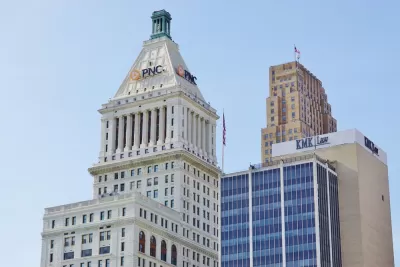The lengths to which the city of Cincinnati should go to attract development investments was up for debate this week.

Nick Swartsell reports on a glut of development subsidies approved by the Cincinnati City Council earlier this week, ranging from an adaptive reuse project that will convert an historic office building to a 262-unit apartment building, a mixed-use development on the riverfront, and many more projects.
"But not everyone is happy about every one of those deals," according to Swartsell. "Some activist groups have objected to the foregone taxes and the lack of affordable housing in the projects. Boosters, however, say they represent valuable opportunities to spur new construction and efforts to rehabilitate significant buildings in the city."
As noted by Swartsell, the largest project is the aforementioned proposal to convert the PNC Tower, built in 1913, into 262 apartments at the cost of $103 million.
"The city has offered a forgivable $2.5 million loan — $1.5 million upfront and another million that will be released later, after the developer makes $9 million worth of facade restorations. Instead of property taxes, the developers would pay into a tax increment financing district created around the building. Eventually, the city would return more than $11 million from that TIF to the developer. The city would keep another $7.75 million. The project has also received federal Historic Preservation Tax Credits."
The Cincinnati Federation of Teachers is one of the leading critics of this development deal, among the others approve this week by the Cincinnati Council. Additional coverage of the deals, and the debate, is also available from an article by Chris Wetterich, written before the council action.
FULL STORY: A Bevy of Cincinnati Development Projects Get Tax Incentives

Planetizen Federal Action Tracker
A weekly monitor of how Trump’s orders and actions are impacting planners and planning in America.

Maui's Vacation Rental Debate Turns Ugly
Verbal attacks, misinformation campaigns and fistfights plague a high-stakes debate to convert thousands of vacation rentals into long-term housing.

San Francisco Suspends Traffic Calming Amidst Record Deaths
Citing “a challenging fiscal landscape,” the city will cease the program on the heels of 42 traffic deaths, including 24 pedestrians.

Defunct Pittsburgh Power Plant to Become Residential Tower
A decommissioned steam heat plant will be redeveloped into almost 100 affordable housing units.

Trump Prompts Restructuring of Transportation Research Board in “Unprecedented Overreach”
The TRB has eliminated more than half of its committees including those focused on climate, equity, and cities.

Amtrak Rolls Out New Orleans to Alabama “Mardi Gras” Train
The new service will operate morning and evening departures between Mobile and New Orleans.
Urban Design for Planners 1: Software Tools
This six-course series explores essential urban design concepts using open source software and equips planners with the tools they need to participate fully in the urban design process.
Planning for Universal Design
Learn the tools for implementing Universal Design in planning regulations.
Heyer Gruel & Associates PA
JM Goldson LLC
Custer County Colorado
City of Camden Redevelopment Agency
City of Astoria
Transportation Research & Education Center (TREC) at Portland State University
Jefferson Parish Government
Camden Redevelopment Agency
City of Claremont




























